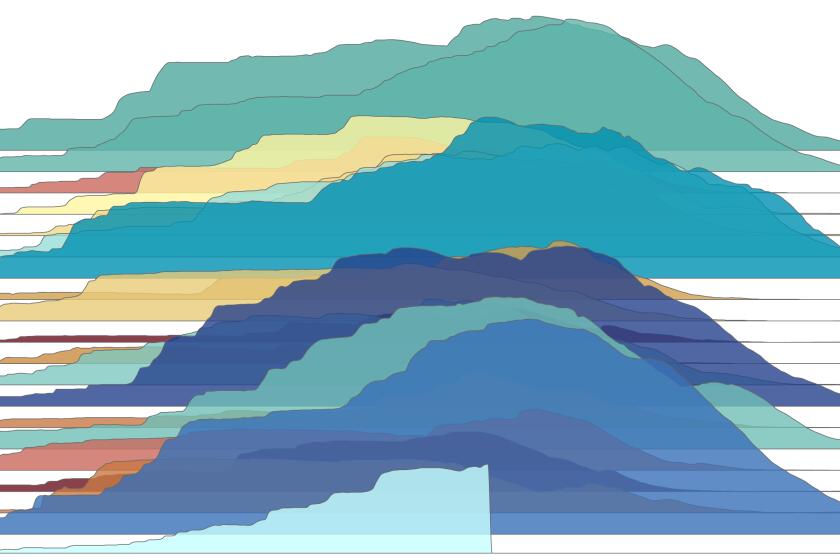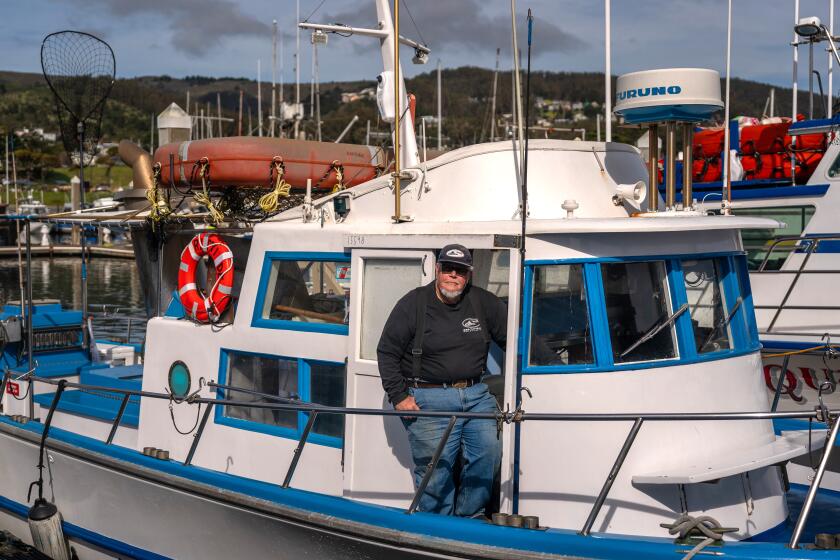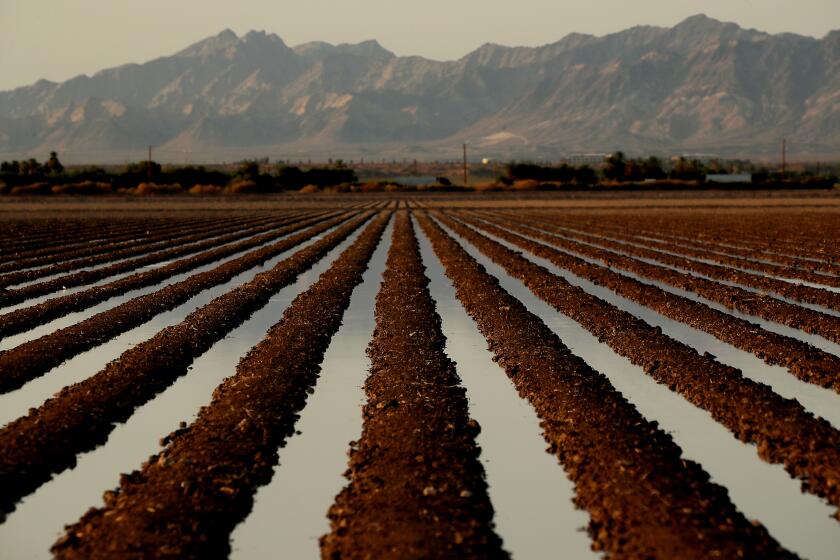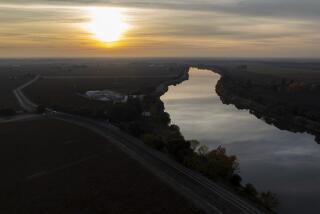
With California snowpack and reservoirs at above-average levels following two wet winters, Gov. Gavin Newsom stood on a snowy field near Lake Tahoe on Tuesday and urged the state to do much more to make its water supplies resilient to the extreme droughts and flooding that come with climate change.
“These extremes are becoming the new reality, and that new reality requires a new approach,” Newsom said. “The water system in California was designed for a world that no longer exists.”
The governor presented a new water plan that lays out priorities for changing how the state captures, stores and moves water, including efforts to replenish groundwater, recycle wastewater and restore the natural ecosystems of watersheds.
Newsom said his administration is focusing on infrastructure projects such as building the Sites Reservoir — the first new major reservoir in decades — and he vowed to move ahead with the proposed Delta Conveyance Project, a 45-mile tunnel that would transport water beneath the Sacramento-San Joaquin River Delta.
“We’re seeing real progress. ... My goal is to get that permitted by the time you kick me out,” Newsom said of the proposal for the delta.
Under state term limits, he is scheduled to leave office in January 2027, at the end of his second four-year term.
This graphic plots a 20-year history of the Sierra snowpack, recalling several other wet years and many more recurring spells of drought.
The governor spoke as the Sierra Nevada snowpack measured 110% of the average for April 1, the typical peak of the snow season. Newsom wore snowshoes as he joined state water managers for their final snow survey of the season.
He said that even with the state’s water supplies benefiting from two wet winters, Californians still need to keep conservation in mind.
“You can take a deep breath this year, but don’t quadruple the amount of time in your shower,” Newsom said.
The state’s five-year water plan, which is required under state law, includes what the governor calls a “roadmap to resilience.” It lays out priorities for modernizing water infrastructure, such as upgrading aging dams and expanding the state’s water-delivery capacity. It also calls for restoring ecosystems to improve the resilience of “natural infrastructure,” such as aquifers and floodplains along rivers and streams.
The plan calls for accelerating efforts to address historical inequities in water management and to deliver solutions for more than 950,000 Californians who rely on systems that have failed to provide clean drinking water.
The plan also — for the first time — includes a chapter focusing on the role of Native tribes in water management, calling for “collaboration and strong partnerships” with tribal nations and “incorporation of Indigenous knowledge and practices.”
In addition to presenting a list of priority actions, the state water plan includes a detailed assessment of climate risks in different regions of the state.
“California’s ability to adapt is not keeping pace with climate change impacts,” the plan states. “The scale of climate-related challenges demands a timely, thorough, and coordinated response from all levels of California government.”
The snow was more than 5 feet deep at Phillips Station near South Lake Tahoe on Tuesday. Officials noted that nine years ago, then-Gov. Jerry Brown had stood on snowless ground at the same spot and declared a drought emergency.
Aggressive and impactful reporting on climate change, the environment, health and science.
In the last decade, California endured two severe droughts, and then the historic series of atmospheric rivers of 2023, which brought one of the biggest accumulations of snow on record and triggered damaging floods in parts of the state.
Newsom noted that this winter began with “bone dry” conditions, but that storms in February and March had pushed the snowpack to above-average levels.
The state’s major reservoirs overall are at 116% of average levels, and are set to rise further as snowmelt streams in.
Shasta Lake is now 93% full and continuing to rise with runoff from the latest rains, while Lake Oroville is at 88% of capacity — still well above their average levels for this time of year.
Captains of fishing boats on the California coast are bracing for salmon fishing to be severely restricted — or possibly canceled for a second year.
But even with its reservoirs at healthy levels, California faces complex water management problems, such as struggling fish populations and the depletion of groundwater in many farming areas.
Chronic shortages of water from the Colorado River, a key source for Southern California, are also forcing water managers to make plans for scaling back water use.
Newsom pointed to his administration’s efforts to establish a “framework” into the future to adapt the state’s water system to the effects of global warming, including diminishing snowpack and longer droughts punctuated by extreme deluges.
He said the state is prioritizing efforts to capture more stormwater and replenish groundwater, while also moving ahead with major infrastructure projects.
“We’re going to build the first new reservoir in half a century in California,” Newsom said, referring to the Sites Reservoir, planned for a valley north of Sacramento to store water for agriculture and cities.
Another key piece of the governor’s water agenda is the proposed delta tunnel, which state officials say would enable them to capture more water during peak winter flows, boosting supplies that are shipped southward to cities and farms through the State Water Project’s aqueducts.
Opponents are trying to block the project in the courts. Environmental groups, fishing advocates and tribal leaders have said the Delta Conveyance Project would harm the delta’s deteriorating ecosystem.
Newsom argued that remaking the water system in the delta is vital if the state is to adapt.
“The Delta Conveyance is foundational. It’s critical if we’re going to address the issue of climate change. It is a climate project. It is one of the most important projects this state can advance,” he said.
Much of the Colorado River’s water is used for agriculture. A new study shows 46% of the water that is diverted is used to grow hay to feed cattle.
The state also faces other thorny debates over water management.
State water regulators are considering alternatives for new water quality standards that will determine how much water may be drawn from the delta.
At the same time, the Newsom administration is promoting its proposal to rely on negotiated “voluntary agreements” in which water agencies would pledge to forgo certain amounts of water and to fund projects to improve wetland habitats.
Newsom said he believes this approach is important to get past a history of litigation that hindered progress in water management.
“None of this is easy,” he said. “Water — you can go back to every good Mark Twain quote. … [It involves] some of the most stubborn and challenging issues that exist, not just here but all over the Western United States.”
“I recognized we have a lot of work to do, and there is a state of mind around flexibility and adaptation and moving away from zero-sum,” the governor said.
The new water plan builds on other initiatives, including the Newsom administration’s water supply strategy for adapting to a hotter, drier climate, which predicts that California could lose 10% of its water supply by 2040.
“We can’t take this snowpack for granted anymore,” said Wade Crowfoot, head of the California Natural Resources Agency.
Even with last year’s vast snowpack and this year’s good snowpack, Crowfoot said, the state might be “headed into an extended drought, the worst in the state’s history.”
“So we have to take advantage of every storm when it comes,” he said.
Toward a more sustainable California
Get Boiling Point, our newsletter exploring climate change, energy and the environment, and become part of the conversation — and the solution.
You may occasionally receive promotional content from the Los Angeles Times.











